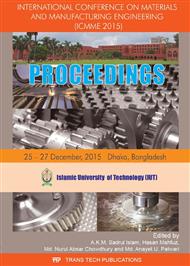p.30
p.35
p.41
p.46
p.52
p.58
p.64
p.70
p.74
3D CFD Based Optimization Technique for Muffler Design of a Motorcycle
Abstract:
In order to minimize the sound transmission due to exhaust gases, the most common and important part of the engine system is muffler. A back pressure on engine is always produce due to the use of the exhaust muffler. This back pressure represents the extra static pressure exerted by the muffler on the engine through the restriction in flow of exhaust gases. The back pressure mainly depends on the internal shape and overall design of the exhaust muffler. Design of muffler is a complex function that affects noise characteristics, emission and fuel efficiency of engine. In this study, a combine model of response surface methodology (RSM) and desirability analysis is used for optimizing the back pressure of a motorcycle reactive muffler, in order to improve the performance of the muffler. For this optimization process, the design variable parameters are size of perforation, number of perforation and chamber size. To measure the back pressure 3D CFD based CAE software has been used. Prediction of acoustics transmission loss virtually is an important analysis required for the development of muffler at an initial design stage. For this reason, for the optimized design virtual acoustics transmission loss analysis is conducted. It is found that after optimizing the design of the muffler, the back pressure is decreased and the acoustics transmission loss is increased that can ensure the improvement of the muffler efficiency.
Info:
Periodical:
Pages:
52-57
Citation:
Online since:
December 2016
Price:
Сopyright:
© 2017 Trans Tech Publications Ltd. All Rights Reserved
Share:
Citation:


